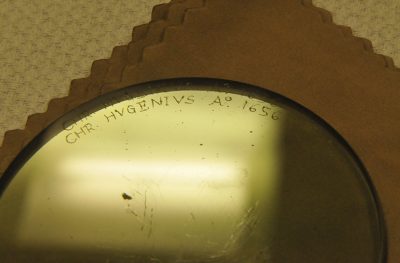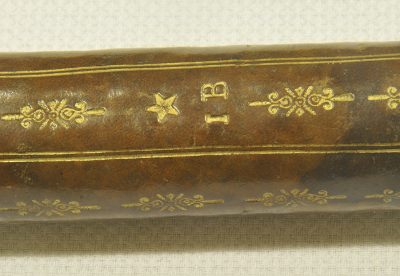Marvin Bolt, the Museum’s curator of science and technology, traveled to Europe last fall to research some of the world’s oldest telescopes. Read along to hear about his adventures and discoveries.
A final day at the Louwman Museum provided access to two of its most important items. One is one of the earliest lenses made by famed Dutch scientist Christiaan Huygens, inventor of the pendulum clock and maker of very high quality telescopes, and the only one in a private collection.
As did many opticians of his day, Huygens signed his lenses with a diamond-tipped stylus, making it very easy for us to date this lens to 1656.
- Huygens lens in its protective case
In his youth, Huygens met René Descartes, who was a friend of his father. Descartes had figured out that a non-spherical lens would improve the telescope, but no one could figure out how to make such a lens. As we investigated the Huygens lens, careful measurements showed that it was not spherical but had consistent differences from the shape of a sphere. This is surprising, and suggests that we will need to examine Huygens lenses in more detail.
The other object, not previously studied in great detail, has circumstantial evidence linking it to the first decades after the telescope first appeared in 1608.
- An early telescope by Jacques Bourgeois (I.B.).
- Detail of an early telescope by Jacques Bourgeois (I.B.).
This telescope is signed “I.B.”, likely Jacques Bourgeois, who published a booklet on telescopes in 1645. As archive scholar Huib Zuidervaart has discovered, Bourgeois signed his booklet with the signature ‘I.B.’
 Our study showed the telescope has a very good objective lens and gives an excellent image. Surprisingly good. It makes us rethink our assumptions about the quality of early lenses, and gives us much to think about as we prepare to look at the world’s oldest lenses in the days ahead.
Our study showed the telescope has a very good objective lens and gives an excellent image. Surprisingly good. It makes us rethink our assumptions about the quality of early lenses, and gives us much to think about as we prepare to look at the world’s oldest lenses in the days ahead.





